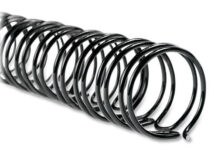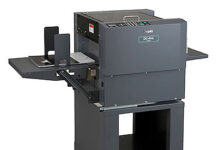by Mike Porter, Print/Mail Consultants
Many consider the hurdles for direct mail advertising to be capturing the recipient’s attention, enticing them to open the mail piece and persuading them to take the intended action. Those all are important aspects of the campaign design phase. Just as important, however, is making sure the piece can be delivered to the intended recipient intact, on time and within budget. If those things don’t happen, the copy, graphics and offer won’t matter much.
Dozens of factors can affect the deliverability of mail pieces through postal systems. Some design characteristics essentially can switch a mail piece from one postal class to another. Others can trigger extra fees and charges. And, a few design miscues can cause the USPS to reject a mailing in its entirety.
Material size, shape, weight and format can determine the speed, quality and accuracy of handling by print and document finishing providers before the job ever gets to the Post Office. Mail piece designers – and printer finishers and binders that work with clients to add specialty folds or effects – should consult with all the organizations involved in distributing the pieces before locking themselves into a design that results in unexpected costs and delays. For the US Postal Service, the people to contact are called Mailpiece Design Analysts (MDAs).
MDA approval not a free pass, but can save the day
MDAs can answer mail piece design questions or evaluate prototypes and provide guidance about improving the design to meet USPS standards. MDAs can save mailers time and money and offer some protection against accepting and running a job that may turn out to be an expensive disappointment.
Many readers of this publication likely are highly skilled and experienced mail professionals. They are certainly qualified to evaluate mail piece designs on their own. But, keeping up on all the guidelines and regulations can be a chore. MDAs can be a second-level defense against bad mail that slips through an internal evaluation process. Or, they can serve as an outside authority on those occasions when customers push back against recommended mail piece modifications. MDA services are free. Mailers might as well take advantage of the resource.
Getting the blessing from a Mailpiece Design Analyst isn’t a guarantee a mailing job will proceed through the postal system flawlessly. Final mail preparation methods or last-minute modifications in piece design, address location or other factors still can cause problems in the mail stream. But, having a favorable MDA opinion could provide some leverage should it be necessary to challenge a USPS ruling about the design of a piece.
I can recall personal experiences where consulting with an MDA saved my customer thousands of dollars or prevented a mistake that would have rendered the mailing useless. In one instance, the customer had engaged a graphic artist to create a folded self-mailer. It hadn’t been printed yet, but the customer supplied a drawing that showed the layout, the location of the folds and the finished dimensions. As it turned out, the MDA noticed the aspect ratio was outside USPS specifications. If we’d printed and mailed the piece as designed, every one of them would have incurred a non-machineable surcharge – a budget-busting $20,000 of unexpected expense. In another case, the MDA pointed out tabs placed in required locations would obscure some important information on the document. We would have unknowingly reduced the response rate to practically zero. Advanced consultation with the MDA really saved the day on both those occasions.
Recognizing the value of the mail piece design analysts, the USPS has launched a help desk application to streamline connectivity between customers and Mailpiece Design Analysts. Customers can get connected with an MDA by calling 855.593.6093 or sending an email to MDA@usps.gov. The MDA customer service help desk is available Monday through Friday from 7 a.m. to 5 p.m. Central Time.
Mailers can find additional information about getting help from MDAs by clicking on the MDA Customer Service Help Desk tab found at https://ribbs.usps.gov.
Creativity within boundaries
Coming up with creative designs can be a struggle. One can do only so many things with a jumbo postcard before it becomes clear a different approach is necessary to make a mail piece stand out. A folded self-mailer, unusual windows, embossing or dimensional mail pieces might be aspects of a campaign designers decide to explore. When they do, it is best for finishing and mailing operations to get the specifications in advance and compare the piece to the mailing requirements and regulations.
Here are a few areas mailers always should consider before approving designs for direct mail pieces.
Size and Shape – Size restrictions differ among mail classes. As a result, mis-sized mail pieces can become ineligible for the intended mail class. A postcard too big for First Class may have to be sent via Standard Mail instead. That might be a problem. Among other things, delivery standards are different between the two mail classes, affecting the timing of the promotion.
Aspect Ratio – The aspect ratio is calculated by dividing the length of a mail piece by the height. The resulting ratio must fall between 1.3 and 2.5. A mail piece with an aspect ratio beyond the approved range can trigger a surcharge assessed to every piece in the mailing. On a batch of 25,000 First Class pieces, the surcharge alone would be over $5,000! Note the USPS considers the dimension of the mail piece parallel to the mailing address to be the length. Printing the address parallel to the short side always will result in an aspect ratio less than 1. The piece may stand out as different, but expect the Postal Service to add that nasty surcharge to the postage bill.
Odd-Shaped Items in Envelopes – Special rules exist for mailing bulky items in envelopes. Flash drives or pens, for example, can damage postal equipment, cause jams or injure postal employees. Mailers may be required to wrap such items. In some cases, it may be necessary to add material to the piece to achieve the uniform thickness required for the mail to run through postal sorting machinery.
Tabs – If using tabs or wafers on folded self-mailers, the mail must meet certain specifications regarding the placement, size and number of tabs required by the Postal Service. Obscured information will negatively affect the performance of the piece, so be sure designers do not place important text or graphics where they will be covered by the tabs. Alternatively, mailers may decide to use transparent wafers or glue, which could increase the cost or cause a delay while waiting for delivery of substitute sealing materials.
Response Devices – The design of any response devices mail recipients will utilize to return information back to the mailer is just as important as the outbound mail. Aspect ratios (see above) apply to response pieces, too. If using a return envelope, make sure the response piece fits in the envelope without requiring the mail recipient to fold or modify the response device. Using window envelopes for reply mail is a great idea, but be sure the response piece inside does not shift such that the return address falls outside of USPS address placement specifications.
Plenty of variables in any mailing contribute to the total project cost. Any time a mail piece design seems unusual, it pays to have it evaluated by the print/mail production team and possibly the Mail Piece Design Analysts. In today’s environment of multi-channel communications, rejected mail or delayed delivery encountered at the last minute can have effects far beyond an individual mailing job. A direct mail piece may be integrated with timed emails, web ads, social media campaigns or events. Failure of a mail piece to meet expectations can ripple throughout an entire campaign.
Mike Porter is president of Print/Mail Consultants. Porter specializes in guiding his clients in the development and implementation of strategic and operational improvements in customer communications. Together with his consulting practice, he also generates custom informational content for document industry professionals to publish in newsletters, blogs, web sites, white papers and trade media. To keep up with Porter’s tips, trends and commentary, visit www.printmailconsultants.com and sign up for Practical Stuff – a free newsletter for customer communication professionals.




